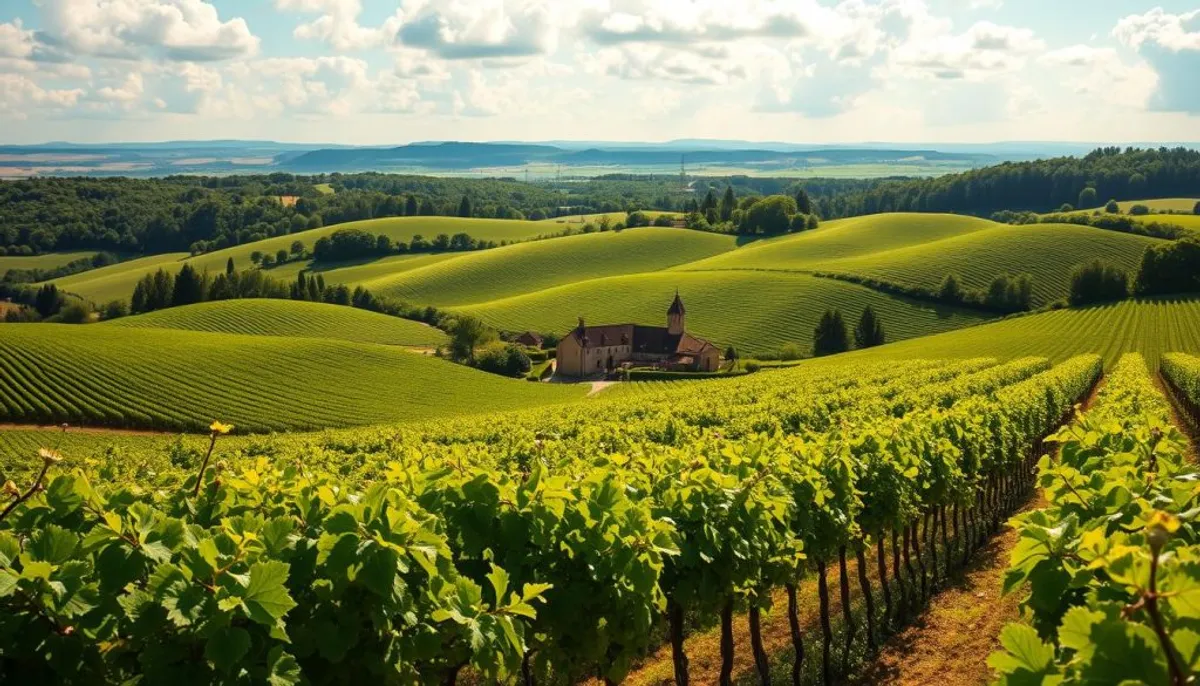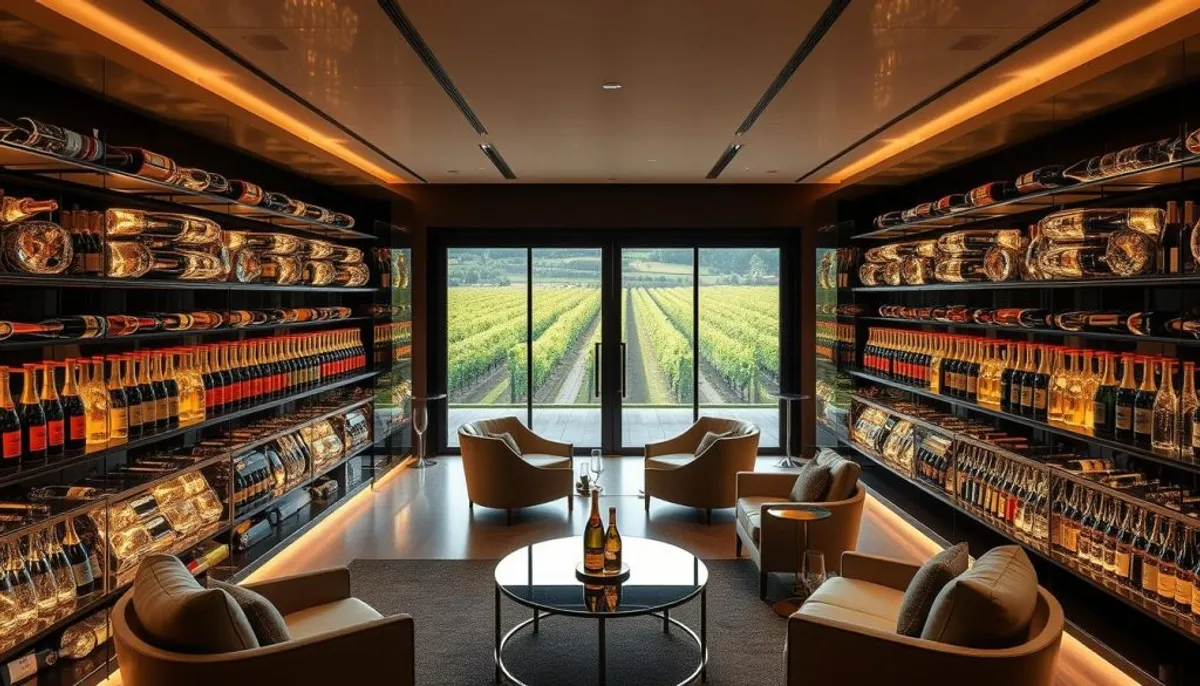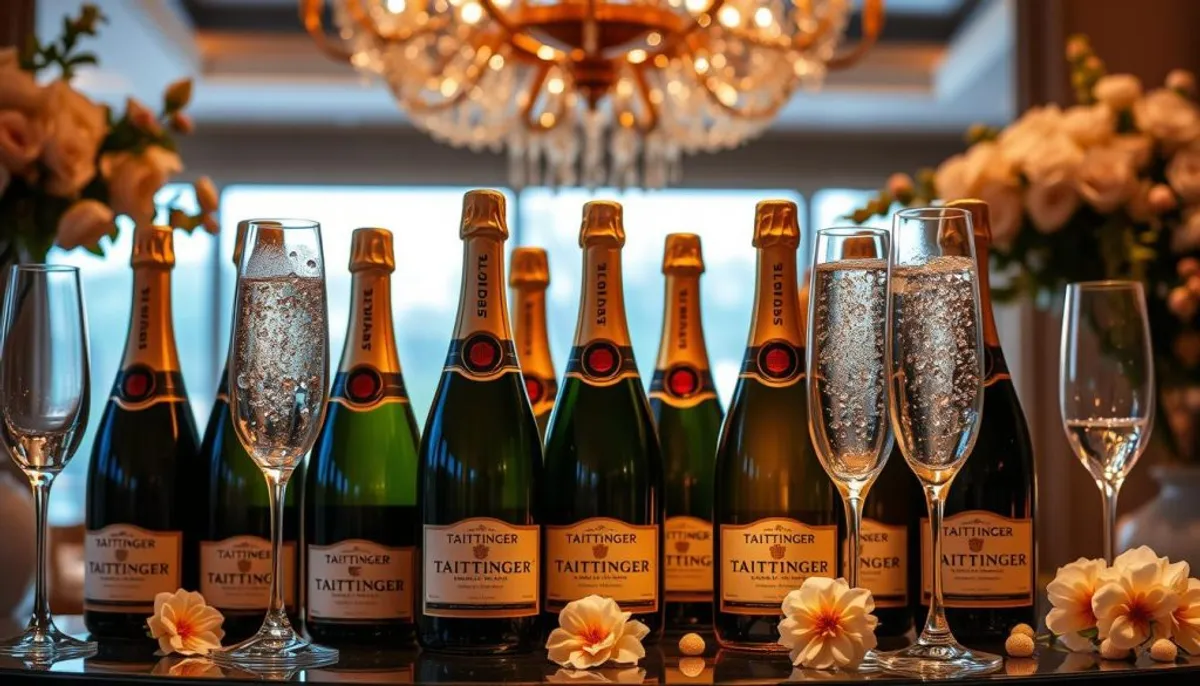In the realm of French champagne, Clovis Taittinger emerges as a visionary, merging innovation with tradition. As the leader of his family’s esteemed Champagne Taittinger house, he exemplifies the synergy between luxury winemaking and a revered family legacy.
Champagne Taittinger, a gem in the French champagne landscape, spans 750 acres across 34 vineyards. This expansive estate enables the house to cultivate 50% of its grapes, a testament to their dedication to quality and control.

The Taittinger style is distinct – characterized by elegance, freshness, and complexity. This unique profile is a result of their preference for Chardonnay in their blends. Their vineyard composition mirrors this, with 37% Chardonnay, 48% Pinot Noir, and 15% Pinot Meunier vines.
Under Clovis’s stewardship, Champagne Taittinger continues to redefine luxury winemaking. They extend the aging process of their wines, resulting in champagnes of unparalleled delicacy and depth. This meticulous approach solidifies Taittinger’s status among the premier champagne houses.
Key Takeaways
- Clovis Taittinger leads the next generation of the family-owned champagne house
- Champagne Taittinger uses 50% estate-grown grapes from 750 acres
- The brand is known for its elegant style, attributed to higher Chardonnay content
- Taittinger ages their wines longer than required for added complexity
- The vineyard composition reflects their Chardonnay-forward approach
- Clovis continues to innovate while preserving the family’s winemaking legacy
The Legacy of Champagne Taittinger
The Taittinger history is a testament to enduring passion and unwavering dedication. Founded in 1734 as Forest-Fourneaux, the family’s journey took a significant turn in 1931. Pierre Taittinger, captivated by the Château de la Marquetterie during World War I, acquired the business.
From Forest-Fourneaux to Taittinger: The 1932 Acquisition
Pierre Taittinger’s acquisition of Forest-Fourneaux marked the inception of Champagne Taittinger. This pivotal moment laid the groundwork for a legacy that would transcend generations. Today, Pierre’s great-grandchildren, Clovis and Vitalie, helm the company, cementing its status as a global champagne icon.
The Château de la Marquetterie Heritage
The Château de la Marquetterie epitomizes Taittinger’s storied heritage. Beyond being the family’s residence, it is the bedrock of their winemaking endeavors. The château’s vineyards underscore Taittinger’s stature as the third largest vineyard owner in the Champagne region.
Family Values in Modern Winemaking
Taittinger’s adherence to family values is evident in their contemporary winemaking ethos. Spanning nearly 40 vineyard plots, they cultivate a blend of Pinot Noir, Chardonnay, and Pinot Meunier grapes. Their commitment to quality and environmental stewardship has garnered recognition, including Viticulture Durable en Champagne and Haute Valeur Environnementale accreditations in 2017.
| Grape Variety | Percentage |
|---|---|
| Pinot Noir | 48% |
| Chardonnay | 37% |
| Pinot Meunier | 15% |
Taittinger’s Distinctive Winemaking Philosophy
Taittinger winemaking is renowned in the Champagne region for its distinctive approach. It focuses on creating elegant, feminine, and light wines. The house’s philosophy emphasizes patience and tranquility, allowing time to transform grapes into fine champagne.
Sustainable Farming Practices
Champagne Taittinger champions sustainable viticulture across its expansive 288 hectares of vineyards. As the third-largest vineyard owner in Champagne, Taittinger’s commitment to eco-friendly practices is unparalleled. Their vineyards are a diverse blend of 37% Chardonnay, 48% Pinot Noir, and 15% Pinot Meunier vines.
Extended Aging Process
Taittinger’s dedication to quality is evident in its extended aging process. The house allows its wines to mature in chalk quarries, enhancing complexity and character over time. This patient approach yields champagnes with fine bubbles and a distinctive fresh, vibrant style.
The Chardonnay Advantage
Taittinger’s focus on Chardonnay sets it apart. With 37% of their vineyards dedicated to Chardonnay, significantly higher than the regional average, Taittinger crafts wines celebrated for their finesse, elegance, and vibrant acidity. The iconic Comtes de Champagne Blanc de Blancs, made solely from Chardonnay grapes, exemplifies this commitment to excellence.
| Aspect | Taittinger Approach | Industry Standard |
|---|---|---|
| Chardonnay Planting | 37% | 27% |
| Vineyard Ownership | 3rd Largest | Varies |
| Aging Process | Extended in Chalk Quarries | Varies |
| Dosage | Old Champagnes Only | Often Includes Brandies |
Clovis Taittinger: Leading the Next Generation

Clovis Taittinger is a pivotal figure in the champagne industry, leading the family business into the future. As Director of Exports, he is instrumental in expanding Taittinger’s global footprint. The brand’s champagnes now reach 150 countries, with the UK, USA, and Germany being the primary markets.
At the core of Clovis’s leadership is a commitment to champagne innovation. He collaborates with his sister Vitalie, who became president in 2020, and Damien le Sueur, responsible for production and finance. This synergy ensures Taittinger’s continued excellence and adaptability to evolving market needs.
The Taittinger family’s resolve was tested in 2005 when the group was sold to Starwood Capital for €2.1 billion. Pierre-Emmanuel Taittinger, Clovis’s father, successfully repurchased the Champagne division for $850 million in 2007. This transaction underscored the family’s unwavering commitment to their champagne heritage.
Under Clovis’s stewardship, Taittinger remains dedicated to sustainable practices and maintaining its distinctive champagne production style. His leadership is essential in navigating the complexities of the global wine market. This includes the burgeoning wine market in India, where consumption is expected to rise substantially in the future.
Innovation Meets Tradition
Taittinger Champagne seamlessly merges modern techniques with the timeless traditions of winemaking. This synergy ensures the preservation of classic methods while embracing sustainable innovation. This approach is pivotal in maintaining the essence of champagne production.
Modern Production Techniques
Taittinger employs advanced technology to refine their winemaking process. They’ve integrated sophisticated fermentation tanks and pressing equipment. These innovations enable precise temperature and pressure control, guaranteeing consistent quality in every bottle.
Preserving Historical Methods
Despite embracing modernization, Taittinger remains steadfast in its commitment to traditional winemaking. They adhere to the use of only first press juice and extended aging processes. This dedication to craftsmanship yields champagnes with profound depth and complexity, paying homage to their heritage. When considering the overall market, it's important to look at champagne prices in australia to understand the value of such exquisite craftsmanship.
Sustainability Initiatives
Taittinger’s dedication to sustainable innovation is evident in their vineyard management. They’ve adopted organic farming practices and significantly reduced chemical use across their 288 hectares. These initiatives have resulted in more vibrant grapes and a reduced environmental impact.
| Aspect | Traditional Method | Modern Approach |
|---|---|---|
| Grape Selection | Hand-picked | Optical sorting technology |
| Fermentation | Oak barrels | Stainless steel tanks with temperature control |
| Aging | Chalk cellars | Climate-controlled warehouses |
| Sustainability | Limited focus | Organic practices, water conservation |
Taittinger’s integration of innovation and tradition solidifies their leadership in sustainable champagne production. Their methodology respects historical winemaking while incorporating modern advancements. This results in exceptional wines that showcase both their terroir and environmental stewardship.
The Taittinger Vineyard Portfolio
Taittinger vineyards cover an expansive 752 acres within the Champagne region. This extensive portfolio encompasses prestigious Grand Cru sites in the Côte des Blancs and Montagne de Reims. These regions are celebrated for their exceptional grapes, which are fundamental to Taittinger’s acclaimed Grand Cru champagne.
Grand Cru Locations
The Grand Cru vineyards in Taittinger’s portfolio are essential for crafting their esteemed champagnes. These sites boast ideal soil conditions and microclimates, resulting in superior grapes. The Côte des Blancs, renowned for Chardonnay, and Montagne de Reims, celebrated for Pinot Noir, are crucial to Taittinger’s diverse terroir-driven wine offerings.
Estate-Grown Grapes
Taittinger cultivates 50% of its grapes across 34 vineyards. This strategy ensures strict quality control over their grape production. By growing their own fruit, Taittinger guarantees consistency and excellence in their champagnes. This reinforces their status as the second-largest vineyard owner in Champagne.
Terroir Diversity
The varied terroir of Taittinger’s vineyards is vital in crafting complex and nuanced champagnes. Each vineyard site imparts unique characteristics to the final blend. This diversity allows Taittinger to offer a broad spectrum of styles, from the widely available Brut Réserve to the prestigious Comtes de Champagne Grand Crus Blanc de Blancs.
| Grape Variety | Percentage in Blend | Primary Region |
|---|---|---|
| Chardonnay | 40% | Côte des Blancs |
| Pinot Noir | 35% | Montagne de Reims |
| Pinot Meunier | 25% | Marne Valley |
Signature Champagne Collections

The Taittinger champagne range exemplifies the house’s unwavering commitment to quality and the expression of terroir. It spans from the classic Brut La Française to the unparalleled Comtes de Champagne, offering a broad spectrum of prestige cuvées.
The Brut Réserve stands as a cornerstone within the Taittinger collection. It is a blend of 35% Pinot Noir, 25% Pinot Meunier, and 40% Chardonnay, sourced from 35 different vineyards and vintages. This non-vintage champagne, often enjoyed from een zwarte fles champagne, undergoes a minimum of three years of aging on lees, resulting in a rich, complex flavor profile.
At the zenith of the Taittinger champagne range is the Comtes de Champagne Blanc de Blancs. Since 1952, this prestigious cuvée has epitomized Taittinger’s mastery. It is crafted exclusively in exceptional years, with only 35 vintages produced to date. This 100% Chardonnay masterpiece originates from the finest Grand Cru vineyards and is aged for a decade before its release.
Taittinger’s dedication to artistry transcends the bottle. The Taittinger Collection, initiated in 1983, transforms champagne bottles into artistic masterpieces. This endeavor involves collaborations with celebrated artists, resulting in unique, collectable pieces. These limited editions have garnered significant attention, with some vintages commanding impressive prices at auctions.
| Cuvée | Grape Composition | Aging | Production |
|---|---|---|---|
| Brut Réserve | 35% Pinot Noir, 25% Pinot Meunier, 40% Chardonnay | Minimum 3 years | Part of 5 million bottles annually |
| Comtes de Champagne | 100% Chardonnay | 10 years | Limited production in exceptional years |
Global Market Presence and Strategy
Taittinger’s global wine market presence is truly remarkable. As the sixth-ranked Champagne brand worldwide, it boasts a champagne export strategy that spans 150 countries. The company’s annual production of 6 million bottles highlights its pivotal role in luxury brand marketing.
International Distribution Networks
Taittinger’s global reach is bolstered by a network of 150 distributors. The UK, the largest champagne export market, is a critical focus area. Taittinger has made groundbreaking moves, such as acquiring 70 hectares in Kent for sparkling wine production. This marks it as the first French Champagne house in the UK.
Brand Positioning
Taittinger is positioned as a premium brand in the global wine market. Its star products, Comtes de Champagne Blanc de Blancs and Rosé, embody this luxury status. The brand’s prestigious partnerships, including being the official champagne for FIFA events, further enhance its global appeal.
Market Adaptation Strategies
Taittinger adapts to diverse markets while preserving its core identity. In California, it produces sparkling wine under the Domaine Carneros label, utilizing local grapes and traditional methods. This strategy allows Taittinger to meet specific market preferences while maintaining its commitment to quality.
| Metric | Value |
|---|---|
| Global Ranking | 6th |
| Annual Production | 6 million bottles |
| Export Percentage | 70% |
| Countries Reached | 150 |
| Annual Revenue (2013) | €130 million |
Family Business in Modern Times
The Taittinger family has adeptly navigated the complexities of modern luxury brand management. In 2007, they reclaimed their winemaking heritage, solidifying their status as a generational business in the competitive champagne sector.
Clovis Taittinger, at 31, embodies the new era of this esteemed brand. He collaborates with his father and sister, upholding the family’s tradition while fostering innovation. This trio manages 900 acres of vineyards and partners with 300 premier grape suppliers in Champagne.
Their commitment to quality is evident in their production methods. Taittinger crafts seven distinct champagne expressions, prioritizing excellence over quantity. Among these, the renowned moët & chandon cellars stand out, reflecting the pinnacle of craftsmanship. They produce 6 million bottles annually, a figure that underscores their dedication to maintaining high standards.
Clovis is pivotal in the company’s global strategy, working with 110 agents worldwide to promote the Taittinger brand. His role extends to the tasting committee, ensuring each bottle adheres to the family’s rigorous standards.
Looking ahead, Taittinger is expanding its scope. They are constructing a welcome center in Reims and exploring ventures beyond wine, capitalizing on their expertise in luxury hospitality. This forward-thinking stance, combined with their rich heritage, makes Taittinger a paradigm for family-owned businesses in today’s world.
Sustainable Practices and Environmental Commitment
Taittinger leads the way in sustainable viticulture within Champagne. This family-owned estate has adopted eco-friendly winemaking methods, establishing a new benchmark for organic champagne production. Additionally, they support women winemakers, promoting diversity and innovation in the industry.
Organic Farming Initiatives
Taittinger’s dedication to sustainable viticulture is clear through their organic farming practices. Despite the Champagne region’s challenging climate, they’ve successfully eliminated chemical pesticides from their vineyards. This move not only protects the environment but also elevates the quality and distinctiveness of their champagnes.
Carbon Footprint Reduction
The winery has introduced cutting-edge strategies to diminish its carbon footprint. These initiatives resonate with the industry’s increasing emphasis on sustainability. In 2022, Charles Heidsieck and Piper-Heidsieck became the first Champagne Houses to achieve B-Corp certification.
Water Conservation Methods
Taittinger has been at the forefront of water conservation in their winemaking process. These efforts mirror a wider trend in the industry. In 2023, four restaurants were awarded a Michelin ‘Green Star’ for their commitment to sustainability.
| Sustainable Practice | Impact |
|---|---|
| Organic Farming | Improved soil health, biodiversity |
| Carbon Reduction | Decreased emissions, energy efficiency |
| Water Conservation | Reduced water usage, improved resource management |
Taittinger’s commitment to sustainable viticulture and organic champagne production serves as a model for the industry. Their eco-friendly winemaking practices not only benefit the environment but also enhance the quality of their champagnes. This ensures a sustainable future for this esteemed brand.
Awards and Recognition
Champagne Taittinger’s dedication to excellence is evident in its extensive collection of awards and global acclaim. The brand’s consistent high wine ratings underscore its commitment to quality and craftsmanship. At the heart of this success is Clovis Taittinger, who embodies the family’s legacy globally.
For 14 consecutive years, Champagne Taittinger has been the preferred champagne at the Screen Actors Guild Awards. This enduring partnership solidifies the brand’s stature in the entertainment world. At the 20th Annual SAG Awards, Clovis Taittinger led the champagne toast, marking a pivotal moment for the brand.
The event featured Taittinger’s Brut La Française NV, served to Hollywood’s elite at both the ceremony and post-awards gala. This choice highlights the brand’s appeal among connoisseurs and its ability to enhance grand celebrations.
| Event | Recognition | Champagne Served |
|---|---|---|
| 20th Annual SAG Awards | Official Champagne | Brut La Française NV |
| SAG Awards Red Carpet | Opening Toast | Nocturne NV-inspired |
Taittinger’s presence at such prestigious events not only highlights its global recognition but also solidifies its status as a premier champagne producer. The brand’s consistent participation in celebrating film and television achievements showcases its enduring appeal and quality.
Conclusion
The Taittinger legacy is a powerful symbol of family-driven champagne innovation. Spanning over four centuries, this renowned house has consistently produced exceptional wines. Currently, they produce 6 million bottles annually, with the Brut Réserve making up 70% of this output.
Clovis Taittinger, alongside his sister Vitalie and father Pierre-Emmanuel, is shaping the future of luxury wine. Their dedication to quality is reflected in their extensive vineyard holdings, totaling 270 hectares. This makes them the second-largest vineyard owner in Champagne. It ensures that half of their grapes are sourced from their own estates, ensuring consistency and excellence.
The brand’s innovative spirit is evident in creations like the Prélude cuvée and the unique Folies de la Marquetterie. These wines demonstrate Taittinger’s ability to merge tradition with modern winemaking techniques. With prices ranging from €47.90 to €280.00, Taittinger offers a champagne for every occasion. This solidifies its position in the luxury wine market of tomorrow.
RelatedRelated articles



